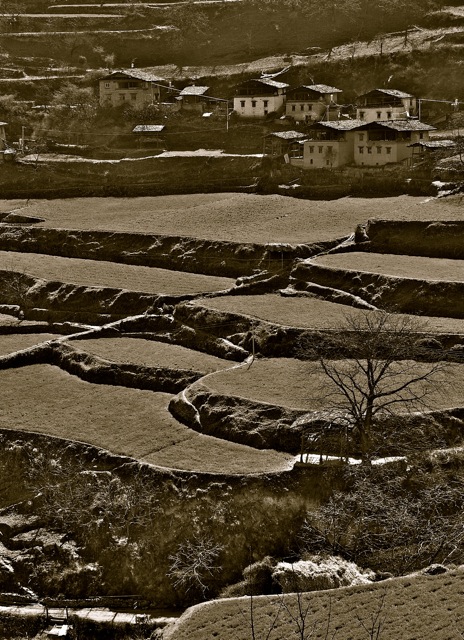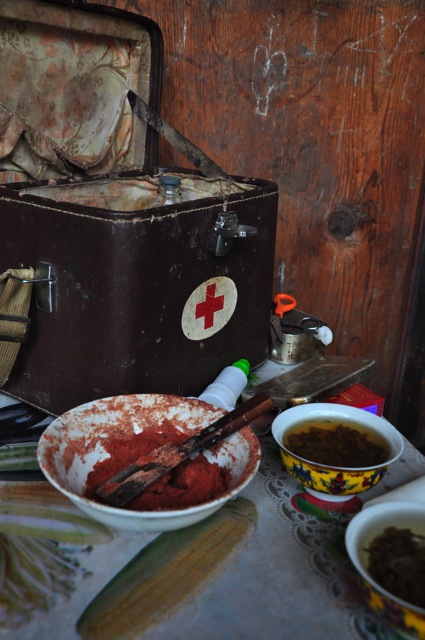Within a valley west of Shangri-La’s vaunted title and grasslands, over the Shika range of mountains, around 40 bends, heat rages even as autumn and winter start to claw their way into the geography. It is a region that the Tibetans refer to as the ‘rong’ba’ or ‘valleys’. Wujing is its name and Wujing is where I go via a tiny breadbasket-sized van, which sputters its way along.
Wujing is one of those places, which refreshes, because there simply isn’t a quick way to get there. A curling road heads first north towards Nixi and then Benzilan, then bends west and then finally south around mountains. A wandering two-lane line of asphalt cuts along the side the land, which rises on all sides. And as with any rise, there is a fall, and in this case the falls plunge. Down below, a blue-green waterway carves its way between a little seam of a valley, doing what water does best: following the natural contours of the land.

Getting into some of the nooks and corners of Yunnan requires a certain will and a bit of devil-may-care
I’ve come to find a doctor who sports a beard, pounds back the local firewater in huge gulps, and, who has apparently a cigarette hanging out of the corner of his mouth most hours of the day. Apart from this, he is known as a miracle worker, as someone who uses skills with plants, herbs, and knowhow to help and cure; in other words a bit of a quack to a modern practitioner. His beard, drinking, and abilities are what I’ve come for. He is exactly what the mountains offer up time and again: originals. His little home which runs rampant with goats is often host to lines of people from surrounding villages who seek his council. Personalities like this have to be found in the old manner of finding things and people…through other people.
When I do finally arrive, meeting this ‘legend’ feels exactly as it should: a slight feeling of veneration as he takes my hand in a rough paw and drags me into his ‘sitting room’, which includes scissors, dry flowers, mosquito netting and a bed that smells of wood smoke. Long vertical lines give his face the authentic worn features of an old tree. He is lean and corded with sinewy strength. A cigarette burns down in the corner of the mouth as I had been told it would, and it seems as though he was born with the little butt jammed in there.
Known simply as uncle or Aniè he is an energy force given legs…and a pair of long powerful hands that I cannot take my eyes off of. His diminutive wife looks as if she has suffered – and prospered – from being with someone that she loves entirely; and someone entirely at the whim of his passions.
There is something of the ageing and incorrigible rock star about him. Elegant and refined even with those strangler hands of his he seems a man who lives at a slightly different level of intensity. He has an authentic age that no vanity can touch.
His wife has tea in my hands in less than a minute…and less than a minute after that he has a thimble glass full of the local ‘fire fluid’, made from barley in my other hand. He laughs the laugh of a man who’s happily retained his little habits (of which most are on the naughty side). We take the glass of liquid in one little quick heave and the liquid burrows through the pipes like a slow moving fire.

The valleys, high mountains and river-sheds offer up cures in thatches of green, trees, and under rocks.
Aniè and his vaunted skills with plants had been in my mind for years as locals had long ago told me of a man who in his day, had been a village bad boy, ferocious fighter, enviable drinker, and most crucially to me, a generous soul who treated all who came to him free, turning none away.
His hair is swept back off of his forehead and his life-lines of rage and laughter pull at his intense eyes. He has suffered under the weight of his fire and goodness. I am introduced to what can only be described as his ‘treatment stool’, where patients sit just outside of the home, in front of a blaring red poster of Mao.

A game of cards is taken in by the Doctor in between patients…and he only consumes tea at such intervals, so as to keep the mind clear
One of the first questions he asks of me is if I have visited the isolated Dongba Songjè monastery perching not so distant to the north. This question comes out of his mouth mid-stream while he speaks about how modern medicine is fast and effective initially, but not friendly on the organs nor upon the general health.
“While you are here, you must visit the monastery…it hangs on the mountain’s face and it is a good place to think.” He drifts a little looking introspective before returning to the present. I would have to go, but only after having spent more time with the good doctor.
Today I’m told firmly, “Will not be for talking about me. It will be for enjoying life”. Paraphrased I take it to mean that I will be imbibing equal and very significant amounts of butter tea and the local whisky…and I am correct on that assumption.
One of the wonderful aspects of life in these quarters is that days of the week, times of the day, and even months, seem to slide dangerously away until they mean nothing. There is no ‘special day’, no special moment that cannot be ‘now’. Within the first few hours I’ve forgotten how long I’ve been within this little realm.
Breakfast of the second day is butter tea churned in a wooden cylinder with enough salt to pucker the lips. Incredibly, the ‘doctor’ is exactly as he was yesterday despite an incredible (but I suspect regular) amount of the firewater consumed the night previous. My own head rings slightly from the repeated bowls and I’m almost dreading the first time I will have to turn down a drink today.
Sure enough a first ‘client’ of the day is arriving as we finish up our breakfast (which does involve a shot of whisky). A young farmer has a huge gash, which torn ragged wounds along his ribs and into his stomach. He is silent as Aniè cleans and pulls at the skin, peering inside the blood-caked rips.
The medicines that the doctor uses come from a big green box with the universally accepted red cross painted upon it, as if in a show of solidarity with the rest of the world. What lies within the box however is a bit of mystery as it remains closed. I am allowed to see various bagged powders with characters and numbers on them. They are the hand-crushed and pulverized remains of plants that Aniè carefully picks himself in the nearby mountains. He is careful to tell me that these plants and flowers should be picked only at certain times of the year when their curative elements are at their maximum.
The young man’s gash receives a thick purplish paste that is “part flower, part root”. I’m told that it will leach and purge the wound of any infections and then begin the healing process. After that the young man will return for the doctor’s ‘famous’ paste to finish off the healing. That is as much as I can get out of our doctor, who like any great chef will leave out crucial information, ingredients and perhaps both. The wound is then wrapped snuggly around the body, and the man looks in awe, and perhaps in a little fear at his doctor who against type, remains concentrated and quiet. While Aniè is a veritable machine when socializing in terms of talking, his treatment is done in absolute silence and only when he needs to explain something mutters softly.
As the farmer departs, Aniè reaches for a swig of the whisky – which sits in a nearby jar and seems to remain ubiquitous throughout my time with him – and takes a shot which is followed by one of his magnificent grins. His whisky jar seems to remain mysteriously full, never really dissipating, even though the sips are many. He is of course doing a bit of self-medicating but for a man who is somewhere in his seventies the local hooch seems to be maintaining him quite well. When I ask him about the spirits, he smiles a broad grin and tells me that it has no preservatives, and that it is homemade…and then winks.
Next up in the daily line-up for treatment is a young girl offering up the inside of her right arm. Mid forearm are a series of red lumps that have large centres. They are identical and run up and down her arm and she explains that they haven’t gone away and are painful. Uncle looks at her and then at me, smiling the smile of the diagnostician that he is, and tells us that a local kind of spider is the culprit, and most likely a nighttime assailant.
After lancing and cleaning the red bites, he applies his ‘famous’ paste – that is a deep terracotta colour – to the wounds and puts a small amount of the peanut butter consistency into a rag and rolls it up, giving it to the young girl after imparting some application instructions.
He will not tell me what is in the paste but local lore has it, that it is some sort of mix of powerful mountain herbs that Aniè sources every spring. Much as the medicine (and his unflinching charity) has made him a bit of a worthy celebrity, I suspect there is a social dynamic involved, and a desire to be with and in someway serve his community.

The doctor prepares his famed healing paste made entirely out of secretive blend of herbs and plants that he prepares himself.
Days into my stay with the doctor of the mountains, and in a slight threat of becoming pickled myself with the daily doses of spirits, I pack up and head to the monastery as the uncle suggests.
Heading out he tells me with a serious face that the ills of the body can usually be remedied, but the ills of the mind…he leaves the question to hang. He then repeats how important it is to visit the temple…there is something about the place that he doesn’t speak of but rather infers that makes it a priority for me
In a parting moment though, as if to remind me that he hasn’t gone soft, he gifts me a tiny glass bottle of whisky while his wife hands over a bag of eggs, homemade palè (flatbread), and a collection of sweets.

A question is answered while in mid-treatment. Interruptions were not welcome during doctor-patient time






Your insightful writing and beautiful photos are such a pleasure. You’re certainly not for lack of interesting characters to write about!! Enjoy the beautiful fall where you are. Vancouver has been sunny and warm every single day of September!
Thanks, Jeff.
Kim
Thanks for the note Kim. Winter is slowly tightening its grip here and the winds inevitably lead the charge. These characters are slowly disappearing, though they inevitably retain much passion when there is an audience.
Enjoy the sun Kim.
be well,
Jeff